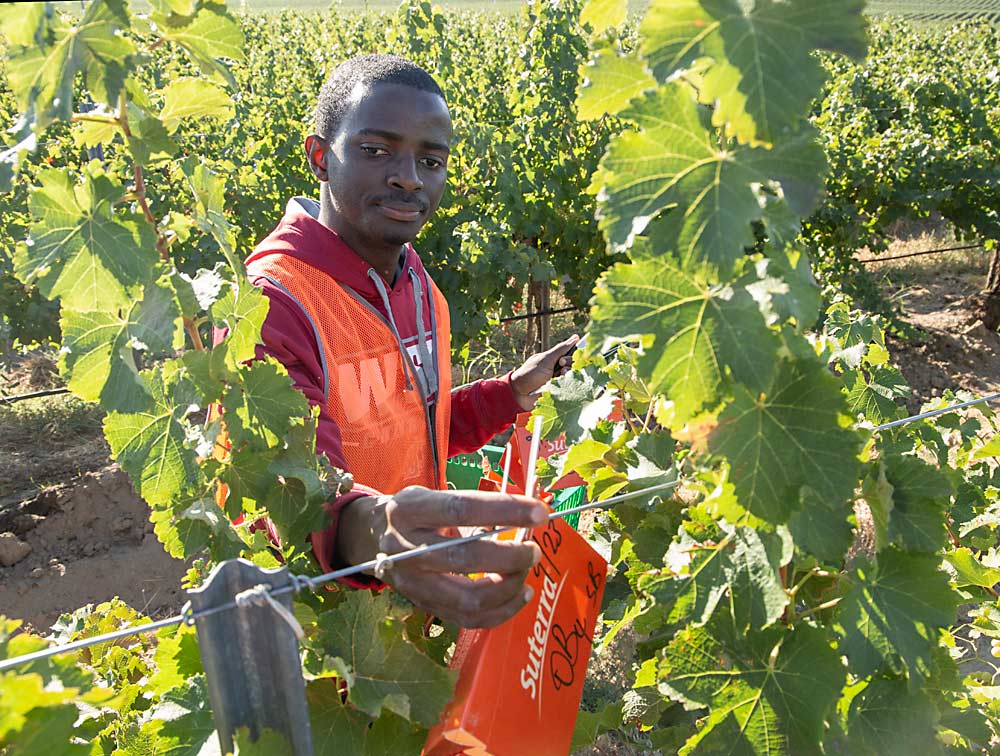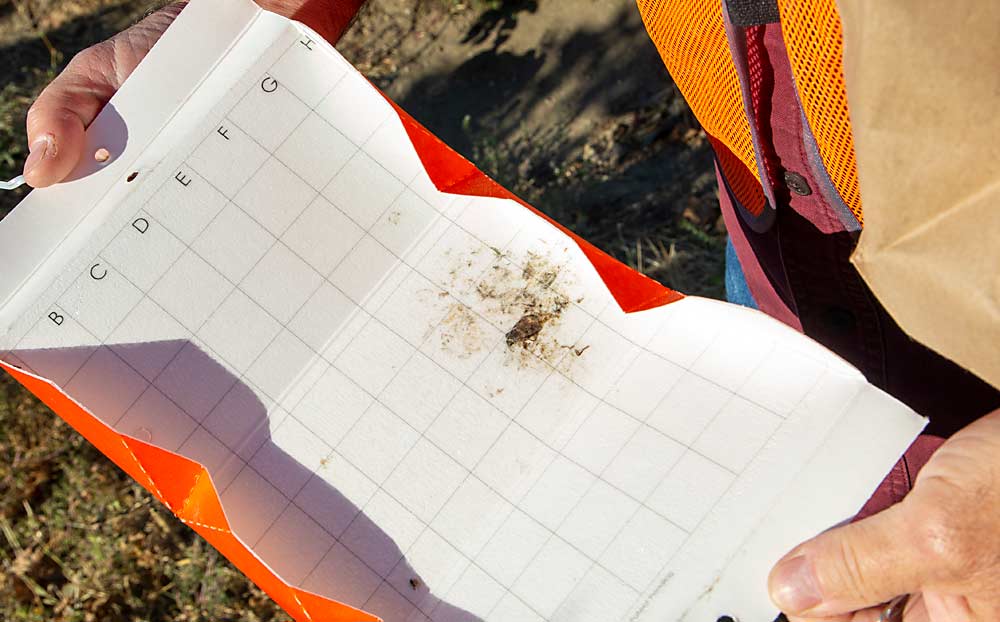
A new grant received by the Washington State Wine Commission will substantially scale up research efforts to create sustainable management of grape mealybugs, the primary vector of grapevine leafroll virus in Washington.
The $205,000 grant, awarded by the Washington State Department of Agriculture as part of its 2022 Specialty Crop Block Grant Program, is led by Washington State University’s Doug Walsh, entomologist, and Naidu Rayapati, grape virologist. The research team will expand on work done in a previous pilot study that showed promising results from mating disruption, applying the technology to larger trials in commercial wine grape vineyards.
Synthetic sex pheromones have been used in many crops to confuse male insects and prevent them from finding females for courtship and mating. Success stories abound, from codling moth in apples to boll weevil in cotton. More recently, mating disruption has been found to help improve control of vine mealybug in California, a cousin to grape mealybug.
The research team is confident they will be able to show that mating disruption is effective against grape mealybug. But, critically, the research grant will expand preliminary work to show whether shutting down mealybug mating also slows the spread of virus in the vineyard.
High priority

Grapevine leafroll-associated virus 3 is the most prevalent and economically destructive of the grapevine leafroll viruses in Washington state vineyards. It’s both a grower and winery problem. For growers, the virus means loss of yield from fewer and smaller clusters, poor vine growth, uneven and delayed fruit ripening, and shortened longevity of the vineyard. For winemakers, infected fruit can lower wine quality due to reduced color and anthocyanins, negative impacts to pH and titratable acids, and in some years the fruit never reaches desired soluble solids or Brix concentrations. Growers are penalized when their fruit fails to “make their sugars,” and, in extreme circumstances, fruit can be rejected. Not surprisingly, grapevine viruses rank at the top of research priorities, according to industrywide surveys conducted annually by the Washington State Wine Commission.
Because there is no cure or treatment, current management practices involve applying insecticides to control the mealybug vector and rogueing (removing) infected vines to slow the spread of virus. Rogueing can be effective when levels of infection are low and adjacent vineyards also implement vector and virus management steps. However, once infection levels reach 20 to 30 percent of the vines in the block, the block should be removed and replanted with plant material certified to be free of tested viruses. Replanting is an expensive option and costs more than $25,000 per acre, not to mention the loss of production.
In recent years, leafroll-associated virus 3 has steadily crept back into vineyards that were replanted with “clean,” certified vines. The tiny mealybug crawlers are easily carried by wind, birds, people and equipment, and some populations are becoming resistant to the industry-standard treatment of imidacloprid. Earlier research conducted by the WSU research team found that a single, infected crawler had a 20 percent chance of transmitting the leafroll 3 virus before it died from the insecticide application. Growers in regions with a high concentration of vineyards are reporting difficulty in managing grape mealybug populations and slowing the spread of virus.
Pilot study
For the past two growing seasons, the Washington wine industry has supported pilot studies to explore the use of pheromone dispensers at various densities in commercial vineyards. Walsh is working with Pacific Biocontrol Corp. and Trécé Inc., two U.S. companies that are leaders in pheromone-based mating disruption products. Pacific Biocontrol dispensers were deployed at 0, 10, 30, 60, 80 and 100 per acre in two 5-acre blocks, per treatment. Trécé Cidetrack dispensers were deployed at 0, 34 and 50 dispensers per acre in three 6-acre blocks, per treatment.
Sentinel traps loaded with pheromone were used to show the rate of “shutdown” of male mealybug capture. Shutdown refers to the point when no more male mealybugs are caught, indicating that the block has been saturated with pheromone to the point males can no longer sense the pheromone that typically attracts them to the trap. Ideally, these confused male mealybugs are also unable to sense the calling female mealybugs, and mating is disrupted.

The preliminary data from 2021 was very encouraging. During the second mating flight in July and August, as few as 10 dispensers per acre were able to substantially reduce mealybug capture in sentinel traps, compared to the control plots with no dispensers. Emitters deployed at 30 dispensers per acre significantly reduced trap capture as well, and deployment of 60 and 100 dispensers per acre resulted in nearly complete shutdown of trap capture of male mealybugs.
The two vineyard sites used in 2021 included an organic block and a conventional block. Both were older blocks that had well-established and high populations of grape mealybug and high rates of leafroll-associated virus 3 infection. Additional data was collected in 2022 to quantify the minimum emitter density required per acre to achieve full mating disruption.
Slowing virus spread
To learn if mating disruption also slows or stops the spread of leafroll virus, the specialty crop grant will fund work in young vineyard blocks with low mealybug populations and low virus infection rates located in Horse Heaven Hills and Cold Creek. Walsh will continue to evaluate the number of emitters needed to achieve male sentinel trap capture shutdown, while virologist Rayapati will monitor the test sites for incidence and severity of leafroll virus using lab-based diagnostic assays. The rate and spread of leafroll virus will be assessed in each of the study’s three years. Vines that test positive will be rogued and removed, and the number of such vines will be quantified to learn if mating disruption reduces the spread of leafroll virus. A substantial portion of the grant supports the virology aspect of this study.
We’re optimistic that mating disruption technology will offer growers a more sustainable tool to manage grape mealybug. But ultimately, it’s about providing growers with an economical and effective tool to slow the spread of leafroll-associated virus 3. We look forward to sharing our progress with Washington’s wine industry in the near future.
—by Melissa Hansen







Leave A Comment